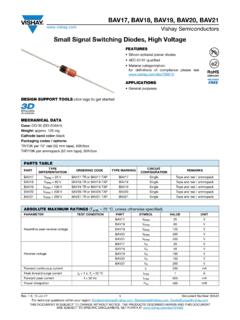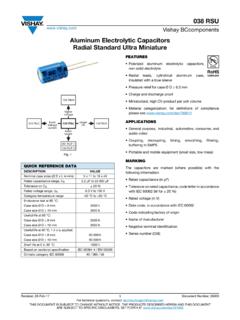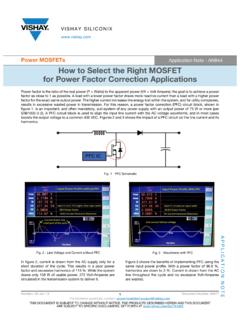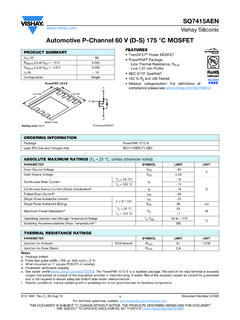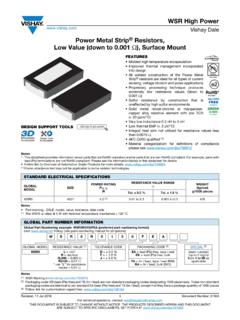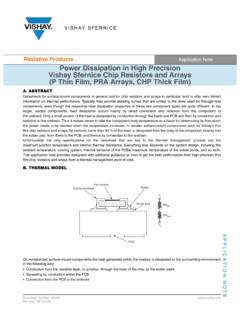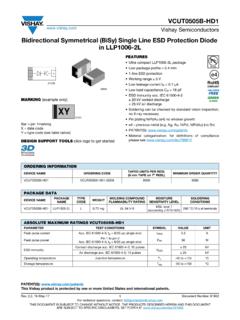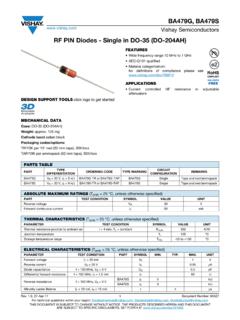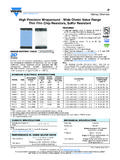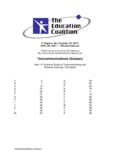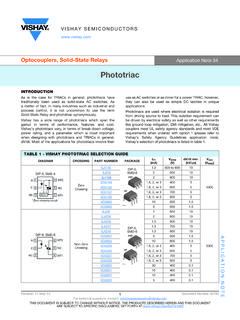Transcription of Faster Switching from Standard Couplers - Vishay
1 Vishay SEMICONDUCTORSO ptocouplers and Solid-State RelaysApplication Note 41 Faster Switching from Standard CouplersAPPLICATION NOTE Rev. 16-Mar-121 Document Number: 83590 For technical questions, contact: DOCUMENT IS SUBJECT TO CHANGE WITHOUT NOTICE. THE PRODUCTS DESCRIBED HEREIN AND THIS DOCUMENTARE SUBJECT TO SPECIFIC DISCLAIMERS, SET FORTH AT offer tremendous advantages in minimizingEMI and noise susceptibility. It is not an exaggeration to saythat a healthy sprinkling of opto-isolation has often meantthe difference between a good idea and working , these very useful devices are often overlooked aspossible solutions in designs because they are perceived tobe slow.
2 It is true that there are some limitations due to theinherent underlying technology involved in optocouplermanufacture. In spite of these limitations, with enlighteneddesign principles, Standard Couplers can be used well intothe microsecond range, or in the case of high-performancecouplers, well into the realm of nanosecond Switching of the higher-speed applications require specializedbut widely available high-speed Couplers . Vishaymanufactures and sells high-speed Couplers ranging fromthe 1 MBd range up to the 10 MBd range. These couplerscan be used in applications were safety and/or noiseisolation is required without sacrificing employing lower-performance standardcouplers can still be optimized for Switching speed.
3 Thoughit can not be expected that these devices will perform to thelevel of specialized high-speed devices, they can be morethan adequate for many Switching applications, up to the 1 s range. These Standard Couplers are the subject ofdiscussion in this document. They fall into two generalcategories, 4 pin Couplers , 6 pin Couplers , as well as aspecial configuration of the single transistor coupler . This photo diode configuration can be schematicallyconsidered as the diode detector version seen in figure1. Fig. 1 In this discussion, we concentrate on the common emitterand common collector Switching circuits illustrated infigure 2. Which of these is most appropriate will bediscussed later on.
4 Fig. 2 The definition for toff and ton used in this document will be asper the drawing on figure 3. Fig. 3 In general, the factors that affect the transient response ofoptocouplers are, in order of importance, as follows:1. IC or collector or emitter load resistor2. RBE resistor value3. Phototransistor current gain (hFE)4. Transistor junction capacitance5. CC vs. CE configuration - Miller effect6. Speed of the LEDSix pin couplerFour pin couplerDarlington six pin couplerDiode detector coupler18924 Common collectorVCC5 V0 V, 4 VMOC8104R4200 k _1 %Common emitterVCC5 V0 V, 4 k _1 %200 189251 ms1 mstontoff1892650 %50 %50 %50 % Faster Switching from Standard CouplersAPPLICATION NOTEA pplication Note Semiconductors Rev.
5 16-Mar-122 Document Number: 83590 For technical questions, contact: DOCUMENT IS SUBJECT TO CHANGE WITHOUT NOTICE. THE PRODUCTS DESCRIBED HEREIN AND THIS DOCUMENTARE SUBJECT TO SPECIFIC DISCLAIMERS, SET FORTH AT VS. PHOTOTRANSISTOR DELAYSS witching speeds below 10 s can be easily achieved withinexpensive transistor output Couplers . Of these two typesof Standard Couplers , the 4 pin variety is probably the mostubiquitous and inexpensive available. It is also the couplerthat has the least number of options, in terms of switchingspeed performance optimization. About the only thing thatcan be done to optimize the Switching speed of these partsis to adjust the load and LED drive there are Switching limitations on the part of theemitter LEDs, in most cases these are insignificant incomparison to the Switching limitations of thephototransistor portion of Couplers .
6 Typical LEDs used inoptocouplers have Switching times that are well below100 ns. Consequently, the dominant concern when dealingwith Standard optocoupler Switching time response is thephototransistor. Even if extreme measures are taken toreduce the Switching delay of Standard optocouplers, theLED delay only comes into play when overall speeds arereduced to the hundreds of nanoseconds. Consequently, forthe purpose of this document, LED Switching is assumed tobe overwhelming dependence on the phototransistor ofthe overall transient response of an optocoupler is illustratedin the oscilloscope waveforms shown in figures 4 and 5. Thefirst figure shows the input and output waveforms ofcommon emitter and common collector configured outputswith a 1K load resistor and a 100K resistor connected fromthe base to ground, with the phototransistor being driven bythe photo current of the LED.
7 The second scope plot differsfrom the first in that it does not rely on photo current to drivethe base of the phototransistor, but drives it directly using a100K base resistor. From the stricking similarity between thetwo plots, one can conclude that the LED contribution tototal switch delay is negligible. Fig. 4 - LED-Driven Optocoupler Fig. 5 - Direct Base-Driven Optocoupler (no LED Delay)PHOTOTRANSISTOR BASICSTo make Couplers more optically sensitive and therebyenable lower LED drive currents, it is desirable to employsensitive phototransistors with high current gain. A moresensitive phototransistor translates into a larger base area,which allows for the collection of more photons and therebygreater photo current.
8 Unfortunately, with larger basecollector junction area comes greater CBC (base collectorcapacitance). But CBC will decrease with increasing VCB, asillustrated in figure 6. Thus, as we decrease the collectorvoltage, the base region capacitance is increased. This, inturn, increases the amount of time required to bring the baseregion to a neutral charge equilibrium. Fig. 6 - CCB vs. VCBNote that the capacitance being discharged is not simplyCBC but C Miller, and in certain circuit configurations thiscan have a tremendous effect on transient response. Moreabout C Miller will be said in the Miller capacitance sectionof this document. The inherent difference between thetransient response of a Standard transistor and aphototransistor can be clearly seen in the oscilloscope plotsin figures 7 and 8.
9 Figure 7 is a transient response of a phototransistor, while figure 8 is a typical response of the189271231 trace = input current2 trace = CC configuration3 trace = CE configuration189281231 trace = input current2 trace = CC configuration3 trace = CE configuration155201000246810121416 CCB (pF)VCB (V)18929 Faster Switching from Standard CouplersAPPLICATION NOTEA pplication Note Semiconductors Rev. 16-Mar-123 Document Number: 83590 For technical questions, contact: DOCUMENT IS SUBJECT TO CHANGE WITHOUT NOTICE. THE PRODUCTS DESCRIBED HEREIN AND THIS DOCUMENTARE SUBJECT TO SPECIFIC DISCLAIMERS, SET FORTH AT 2N3904 NPN transistor. The inherently slowerspeed of the phototransistor is clearly demonstrated.
10 Thetop trace is the input current while the two bottom tracesdepict the CE and CC output waveforms respectively. Fig. 7 - Photo-Transistor Response Fig. 8 - 2N3904 Discrete BJT ResponseIn the case of a 4 pin transistor output coupler , there is noeffective mechanism for charge bleeding from the baseregion other than natural charge recombination and the slowprocess of discharge through the large equivalent baseresistance. Consequently, all that can be done to optimizethe Switching time of a 4 pin Standard coupler is to refrainfrom driving the base junction region of the transistor deep into saturation, as much as possible. This translates intoworking with lower gains and higher drive currents (IF).
